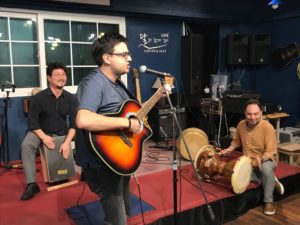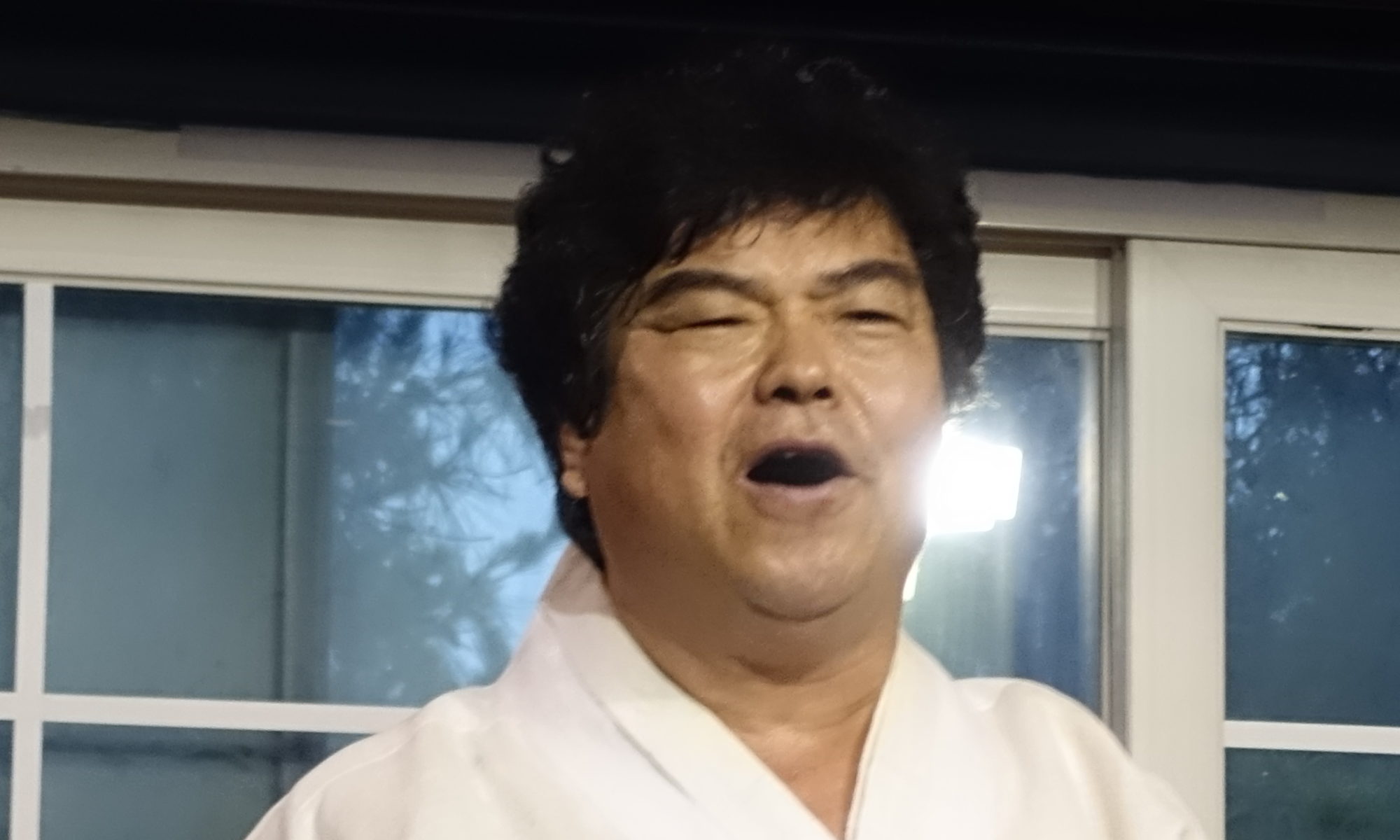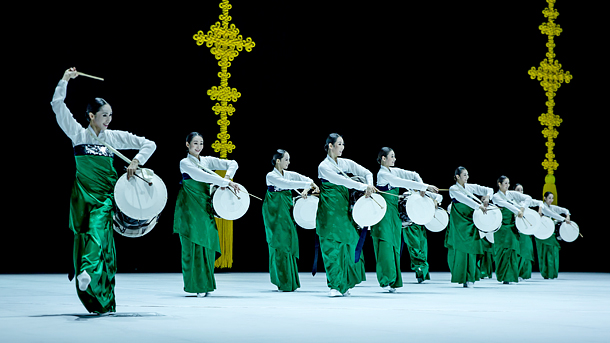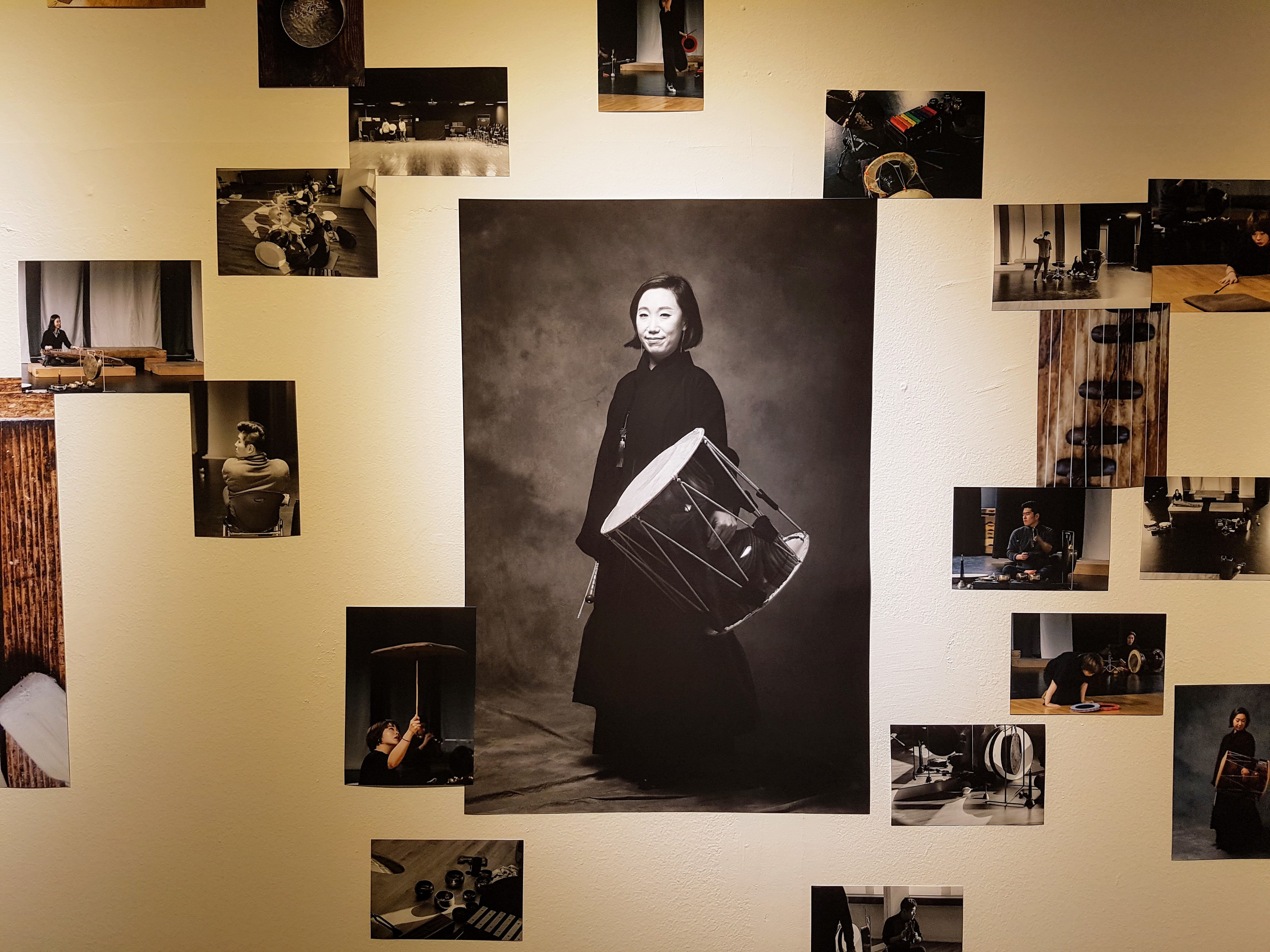f(x)’s androgynous rapper/singer Amber Liu has a new mixtape, and it’s a doozy.
A Communion of Music
As a destination, Daegu doesn’t have much to recommend it. I’d come down from Seoul for one reason only: to see my friend Dong-Won Kim accompany the great pansori singer Bae Il-dong. So when we arrived at the address Dong-Won had sent us, far on the outskirts of Daegu, and found ourselves in the office of a loan shark next door to a tire shop, I was not amused.
After some frantic messaging, we got an updated address that took us deep into one of those ubiquitous beige apartment complexes, and at last we spotted Dong-Won waving his arms on the far side of a parking lot. With Korean musicians, it’s always a little yeogi-cheogi, a little here and there. But perched above a GS25 convenience store in the unlikeliest spot was this delightful little music cafe with an upright bass against the wall and a pair of master musicians getting ready to perform.
We were exactly nowhere, which is where a lot of the best things happen.
Intangible
We arrived in the middle of a screening of the documentary Intangible Asset No. 82, which tells the story of an Australian jazz drummer who comes to Korea in search of an elderly percussionist he’s obsessed with. Dong-Won becomes his guide, introducing him to some of Korea’s finest musicians — including Bae Il-dong — and providing about the best possible introduction to Korean traditional music.
When the film was over, I at last got to hear Bae Il-dong in person. His voice is an extraordinary instrument, raw but supple. There’s nothing showbiz about what he does. His only real trick is absolute mastery of his art form born from total dedication. He once spent seven years singing at a waterfall to develop his voice and find his sound.
Pansori is a storytelling art form, born as a communal activity among the lower classes in Southern Korea in the 19th century, full of humor and pathos, moments of sorrow and moments of joy. Il-dong sang a famous piece in which an old, blind man is reunited with the daughter he thinks he sent to her death — a shock so profound that he recovers his sight. The performance was vivid enough that my friend could grasp the gist of it without understanding the words.
As for me, I was startled by how much I did understand. During the film and the concert — which had a lot of lecture mixed in — I became my friend’s Dong-Won, leaning in to let him know what was going on. And for the first time, I found myself following along with the words of the pansori, even laughing at a few of the jokes I caught.
Community
After the concert, heaps of food were brought in — hearty, traditional Korean stuff — and everybody stayed on to eat and drink together. Dong-Won explained that Korean music is communal, in which the musicians don’t just transmit emotion to the audience, but share in a collective emotional experience.
After a little while, an emcee got up and began to chatter. Dong-Won explained that he was actually a fine musician and dancer who’s known for his skills as a clown and comedian, and soon it was clear what he was up to. He started pulling people up from the audience and getting them to sing: traditional songs, sometimes with Dong-Won pressed into rhythm accompaniment or with a guitarist picking out some backing chords. And these people knew their stuff. No one was at Bae Il-dong’s level, but these were people who’d spent time learning Korean traditional music and dance. Or some of them were, anyway. As the evening went on, the emcee made sure everyone got a chance to do something, whether it was singing an old pop tune or doing a little dance. I got up to dance too, showing off what I can remember of my Korean moves and then putting on the traditional grandfather mask and doing the requisite drunkard’s dance.
 Eventually my friend grabbed a guitar and sang some classic rock — Oasis, Pink Floyd — while Dong-Won played the box and I had some fun thumping along on the janggu. It’s not every day you get to play with a member of Yo-Yo Ma’s Silk Road Ensemble, so you’ve got to grab the opportunity when it comes. My friend sang, I drummed, people danced.
Eventually my friend grabbed a guitar and sang some classic rock — Oasis, Pink Floyd — while Dong-Won played the box and I had some fun thumping along on the janggu. It’s not every day you get to play with a member of Yo-Yo Ma’s Silk Road Ensemble, so you’ve got to grab the opportunity when it comes. My friend sang, I drummed, people danced.
The road to nowhere
I said at the start that the best things often happen exactly nowhere. I’m thinking of a night in the little Burmese trekking village of Kalaw, where some guys at the back of a bar called Hi Snacks & Drinks got out acoustic guitars and sang the night away. I’m thinking of a pansori festival I saw on the banks of a river somewhere in Jeolla province when I lived here as a teacher. I’m thinking of a night spent in an obscure temple with just one other person — my Swiss shaman friend — sitting by the pagoda under the moonlight and listening to the chorus of cicadas and frogs. I’m thinking of northern Laos, where nothing happens, and of the house where I grew up in Marin County, California.
At the heart of Korean music is cyclicality: strong and soft, yang and yin, breath in and breath out, in every note and movement. Right now I’m leading just about the most yang existence imaginable, living in Gangnam and working for Samsung, but there’s an undertow of yin that’s calling to me.
“So save your money and then run away!” Dong-Won said, when we had a chance to talk about it.
Maybe.
“You and I have the same blood type,” he said. “Blood type W. Blood type wind.”
In the film, Dong-Won used a different metaphor from nature: you can be a lake, or you can be a river. A lake stays where it is, but a river is always carving out new paths, flowing where it’s never flowed before. Yeogi-cheogi.
He could have added that a river does this by letting go, not by force of will. I suppose that to heed the call of the yin is first of all to stop worrying about the yang. Things will go how they go. My life has taken enough surprising turns that if I go back over it in five-year increments, I realize that I never really had any idea what was coming. Why should now be any different?
National Music
Some years ago, a professor invited me to a chamber concert at Lincoln Center’s Alice Tully Hall on a Saturday afternoon. Five minutes into the Haydn, he was snoring softly. He was hardly alone. In the half-empty auditorium, I couldn’t see anyone who looked to be under sixty, and much of the audience was nodding off. Even the orchestra seemed to be sleepwalking through their note-perfect renditions of pieces they’d all been playing since middle school.
Why did we all show up for this soporific farce? The audience wasn’t there for the music itself, that was clear. They were part of a generation that felt an obligation to better themselves and their community by patronizing the arts, which meant the classical arts: orchestras, ballet, opera. I was witnessing the dying embers of a kind of Jewish immigrant striving that had put Leonard Bernstein at the center of American middlebrow culture in the mid-twentieth century.
Gugak by Helmut Lang
Something similar (though not so sleepy) was at work during a recent performance — also on a Saturday afternoon — of The Banquet, by the National Dance Company of Korea at the National Theater of Korea, which put dozens of dancers into exquisite costumes and marched them through complex choreography reminiscent of both North Korean mass games and Disney musicals. It was a new piece with lots of modernist trappings, but at its heart it was the same old vocabulary of Korean traditional clothing, stock characters, and dances: the court attendants, the leaping farmers, the women drummers, the upper-class yangban dandies.
With its spare white staging, careful white lighting, and traditional costumes reworked in colors from recent issues of Vogue, a lot of it felt like Korean gugak (tratitional music) by Helmut Lang. Because there were so many dancers on the stage at any one time, it was inevitably more about pretty shapes and stage pictures than about any individual artistry. The precision sometimes lapsed — a wobbly ankle here, an out-of-place dancer there — and it occurred to me that Korea’s very best dancers probably don’t end up as part of this anonymous national corps churning out reheated tradition. The show was never quite boring, and at some moments — especially the farmer’s dance, when individual dancers finally had a chance to show off some acrobatic skill — it was lively. But it was never quite alive. In a Korean sense, you could say that it had no hoheup (breath).
The invention of tradition
As with the Upper West Siders who feel an obligation to sponsor precise renditions of eighteenth-century Hungarian and Austrian music, there are historical and cultural reasons why this particular vocabulary of styles and symbols represents Korean culture, why Koreans enjoy recycling and rewatching these particular cultural artifacts, and why performances with “National” in the title have this zombie quality to them.
The middle of the nineteenth century was a time of extraordinary upheaval, much of which took the form of a reckoning with onrushing modernity: the failed revolutions of 1848 in Europe, the forced opening of Japan in 1853, the Indian Rebellion of 1857, the American Civil War from 1861 to 1865. Ideas of modernity and tradition, reform and reaction, swirled around these conflicts, rarely in straightforward ways. Perhaps no event encapsulates the contradictions of the era as well as the Taiping Rebellion, which took as many as 30 million lives in China between 1850 and 1864. The Taipings were Chinese nationalists who rebelled against the “foreign” Manchu Qing Dynasty, which had been humiliated by the British in the Opium Wars a few years earlier. The Taiping leadership was Hakka, an ethnic minority sub-group within the larger Han Chinese identity, and the head of the movement considered himself the brother of Jesus Christ.
From this maelstrom, independence movements emerged, and they faced the task of forging national identities, whether for relatively organic nations like Korea or Japan, or for colonially invented polities like Indonesia or Malaysia. In Korea, this process was delayed in some ways by the late date of its opening to the outside. The 1894 Donghak (Eastern Learning) Rebellion is an early symptom, but South Korean ideas of national identity really crystalized during the Japanese occupation period, between the World Wars. That’s why the vocabulary of Korean tradition is so specifically that of late-Joseon Dynasty culture, which had ended within living memory. What was being preserved was what the intelligentsia remembered from their youth.
This also has much to do with what made the cut and what didn’t. Palaces are preserved and reconstructed with tax dollars, and national theaters perform the music and dances of both high and low classes because folk was an important concept in the early twentieth century. But most educated people in late Joseon saw Buddhism as retrograde and shamanism as beyond the pale — superstition that needed to be purged if Korean society was to modernize — so there’s relatively little overt Buddhism in Korean traditional performances, while what survives of shamanism in the national vocabulary is usually stripped of ritual power or meaning, and shaman paintings and shrines are almost never given the kind of respect accorded to traditional houses or markets or city gates.
I’m here because we’re here
In country after country, I’ve found similar arts and performances: recreations of Peking Opera in a palace in Beijing, folk ensembles in Luang Prabang, endless repetitions of Mozart in Vienna, dinner buffet dance shows in Siem Reap. (Communist countries tend to produce a socialist-realist version of traditional dance — at some point, ladies will sow seeds and carry water — while capitalist countries are more likely to keep the dance abstract. And Communist performances tend to have brighter and more primary colors in the costumes and lighting, with less deference to the latest Pantone trends.)
Why do people keep showing up to see these same performances, over and over? It has to do with a shared sense of identity and understanding. Koreans can come to a reheated Banquet at the National Theater and nod along, assessing how well or badly the dancers did all the things everyone has been seeing since childhood. It’s art as karaoke: you don’t listen because someone at the bar will sing “I Will Survive” better than Gloria Gaynor, but because you can, as a group, assess the performance against Gloria Gaynor.
And who can engage with Korea’s codified traditions this way? Koreans, of course. That’s where identity comes in. To go to a performance like The Banquet is to reassert both the existence of Korea as a unique cultural entity and your membership in it. That’s why these kinds of performances so rarely innovate or confront: they’re a trip to the folk village, not a trip to the contemporary art museum.
Safety in numbers
Korea does have a traditional music scene that feels alive. The musicians may be playing the old pieces, but they’re bringing personal passion and force to their playing. These performances, though, are usually smaller, without any “National” imprimatur — more downtown theater than Broadway musical. They have hoheup.
Why do they draw smaller audiences? In part, it’s a matter of marketing, budget, and positioning. National theaters have production values, and people show up for that.
But I think there’s something deeper at work too. I have, on several occasions, been moved to tears by Korean traditional music and dance. It happened with So Ra Kim. But being moved and touched can be uncomfortable. It’s raw and real. It’s the equivalent of skipping the folk village, going to an actual village, and reckoning with the ancient, toothless ladies who squat by the side of the road sorting vegetables.
The simulation is tidier, easier. And there’s safety in numbers.
New Old Korea
Kim So Ra is why I live in Korea.
I discovered her this past Saturday night, after a new friend made a vague invitation to a janggu concert. It was a bitterly cold night, and the concert was in an underdeveloped, industrial section of Seoul called Yeongdeungpo, where the main street is still lined with small machine shops and artificial limb wholesalers. It reminded me of winter excursions to the Lower East Side twenty years ago to see experimental theater productions tucked in between old bra shops. I connected with some friends of friends at a chicken restaurant with an outdoor fire rotisserie and stacks of wood, and then we headed off, eventually finding our way to the Mullae Art Factory Box Theater, a stylish bit of postmodern concrete architecture hidden down an unpromising side street.
I wasn’t expecting much. The theater was small, the audience probably fewer than fifty people, and the theme of the show, “A Sign of Rain,” complete with accompanying video projections, seemed like it might turn into the kind of embarrassing conceit that masks mediocre playing.
But the art scene in Seoul, I’ve discovered, delights more often than it disappoints. Kim So Ra, it turns out, is not only a janggu virtuoso, but also a subtle explorer of world percussion, which she integrated into her playing in startling ways, incorporating everything from pouring water to Tibetan singing bowls (only the xylophone piece fell flat). Her fellow musicians — percussionist Hyeon Seung-hun, O No-eul on piri, Im Ji-hye on gayageum — created a rich, complex range of sounds that put me in mind of the Steve Reich performance I saw at BAM in 2015.
Visual music
Traditional janggu performance is inseparable from the excitement of watching the drummer swing the stick from one side of the hourglass drum to the other, and samulnori music comes fully alive as dance, with colorful costumes and long spinning streamers attached to elaborate hats. Kim So Ra augmented that visual tradition with video projections. At times it felt a little Pink Floyd laser show or nineties screen saver, but at their best, the videos helped to focus our attention on particular details in the music, or brought out themes and feelings, as when the screen behind the stage became a dancing watercolor ink painting, creating a kind of willed synesthesia.
Similarly compelling was a burst of modern dance from Kim Jeong-un, whose expressive face and joyous movement brought the theater to life even before she began spinning plates (which is apparently an old Korean art form that predates Ed Sullivan by some years).
The cleverest effect was a projection onto a white-painted janggu, timed to the rhythm so that drum hits became splashes of water and bursts of color. What could have been a gimmick turned out to be powerful and moving, in no small part because of the general tendency in Korean art to take craft seriously.
More than fusion
That all of this is happening in Seoul, right now at this moment in history, is a big part of why I’m here. Other than Japan, there’s nowhere else in Asia where artists are bringing together traditional and global ideas not as fusion — a flaccid affair that usually means old instruments and shitty synthesizers — but as serious postmodern art.
And right now, I think Korea’s more vibrant than Japan, or at least a lot newer and fresher at this particular game. It’s only in the past few years that young Koreans have started venturing out into the world, but they’ve gone in droves to the art and fashion institutes in the US, and what they’ve brought back with them is starting to take root. Fashion, music, art: Seoul feels like it’s on the cusp of something. Artists like Kim So Ra are why I’m here now, ready to wander off into weird neighborhoods in the freezing cold to see what’s happening.
Odd eye
PMS
Korean fusion
Korean fusion
Sexy Clap
“Sexy Clap” is a perfectly reasonable thing to call a K-pop song if you don’t know American English slang.




